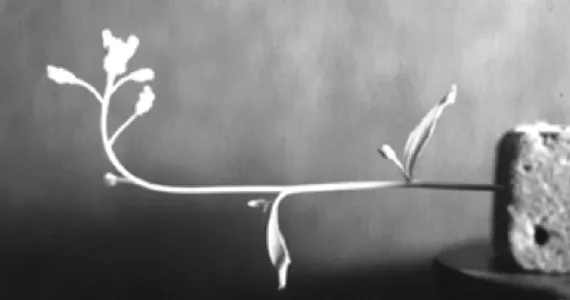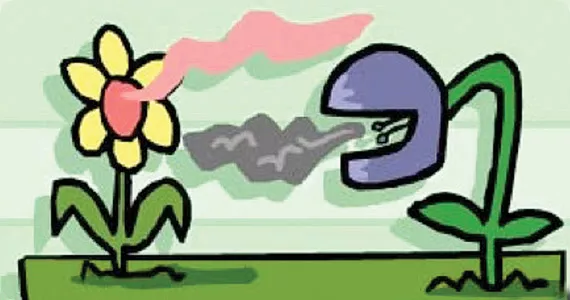Plants don’t have the same senses as we have but are pretty good at forming a picture of the world around them. And they can even influence this and can communicate with each other and other creatures.
Plants have many ways of interpreting their environment. Plants can tell the difference between above and below. You can imagine that it would be disastrous if a seed were to grow downwards into the soil. Plants that are in the dark have a bigger chance of finding light above rather than anywhere below. The contrary is the case for roots that need to grow downwards to find water. But how can a plant tell the difference between above and below?
Inside plant cells there are what we call organelles. Organelles are the cell’s organs. Some of these organelles are granules. The best known example of such a granule is certainly the chloroplast granule that uses sunlight to make sugars. If these sugars are not needed immediately the plants stores them as another type of granule, in the form of starch; we call these starch granules. Starch granules can be found in the parts of the plant that grow, such as the growing points. But starch granules are more than just places for storing sugars. Because of gravity the sugars are always at the ‘bottom’ of the growing cells and that’s how the plant knows which way is below and so in which direction it must grow.

Blue light
Besides gravity, light also tells the plant which way it should grow. Plants grow toward light and, to be precise in the direction of where the light is most blue. The reason for this is that plants absorb large amounts of blue light. So the more blue light there is, the fewer other plants there are that want to use the light. Plants use what are called a photoreceptor to perceive the colour blue. But blue is not in fact the only colour that plants use to see each other.
Plants are green because they mainly absorb the red part of the visible light spectrum. Plants can also use the quantity of red light (to be precise, the relationship between red and far red light) to determine if and where other plants are in the vicinity.
Seeds use this trick to decide when best to germinate. Growing plants will grow taller to get out of the shadow of plants that are around them, they may also grow in another direction.
Tasting with roots
Plants taste and smell as well. They taste below ground, using their roots. Plants secrete substances below ground which allows them to absorb nutrients; other plants can use their roots to taste these. Based on what they taste they can tell how strong and how far away other plants are. A plant uses that information to decide whether or not to get into the underground contest for nutrients and water. They can also sense matter from the above ground parts of the plant that have been washed down by the rain into the ground.
Above ground plants smell each other. If plants smell ethylene they know other plants are nearby. Plants can in fact smell more types of substance. We’ll take a look at that next time. We’ll also see whether it’s true that your plants communicate with each other and how it is that plants grow better if you talk to them.
A less tasty plant
You could very probably get the impression that plants are each other’s enemies and can only perceive things in order to compete for light and nutrients. This is only partially true. Plants warn each other of approaching danger such as foraging animals and insects.
If a plant is being eaten, it secretes a substance that makes it less tasty. In addition to this it also secretes other substances to warn plants in the neighbourhood of catastrophe. This can be secreted both above and below ground, but are usually aromatic substances. This happens, say, when attacked by spider mites. Once warned, the plants around them also manufacture these aromatic substances and so pass on the warning in turn while they also make themselves less tasty for the insects. Unfortunately this strategy is less effective indoors. You can understand that spider mites have little choice when in a growing room and have to put up with a less tasty meal.

If you’re thinking that plants start panicking and are going to send distress calls all over the place every time a leaf gets torn, you’re mistaken. Plants know exactly when insects are eating them because they recognise their saliva. They even know which insect is eating them and pass that precise information on.
It’s not only plants that can interpret these signals. Predatory mites and other natural enemies respond to these signals too. Evolution has so arranged things that they know that a tasty meal awaits them where the odour given off by these signals is the strongest.
Plants communicate underground with other organisms as well. They call on certain fungi and bacteria for help when there are not enough nutrients available. Plants do this by secreting very small quantities of certain substances. The micro-organisms release nutrients for the plant and get energy-rich sugars in return. Other advantages for the plant are an increased resistance against soil pathogens and improved resistance to dehydration.
Talking with plants
It’s a well-known fact that there are people who say that plants do better when you talk to them. Although researchers have been working for a long time on the question of whether plants react positively to speech, no convincing research has been published to date. But there are also people who really have experienced the positive influence of speech on their plants.
One possible explanation is that they don’t only talk to the plants but they also touch them. Plants do have a sense of touch. Researchers discovered this when doing a test involving plant hormones. It turned out that not only did the plants that were given the hormone stay smaller, but so did the plants that were given a substance that was entirely inactive. The reason for staying small appeared to lie in the plants being touched when the substance was applied and not in the hormone itself.
Plants stay smaller if touched
What has this got to do with the positive influence on a plant if it’s touched? In addition to being smaller the plant goes on flowering longer. These reports tend to concern plants that give flowers such as roses.
In addition to delayed flowering and staying small, plants that are touched frequently have smaller leaves, reduced photosynthesis and accelerated ageing. How it is that a plant’s development and growth can be influenced by being touched is not precisely known today, but if you touch your plants often you can be sure of a smaller harvest.

Although no organisms have been found on plants that allow them to perceive sounds, they do react to music and can distinguish this from ’conventional’ sound. The influence of tones and music on plant growth and development is a relatively new area for science, but a lot of research is going on.
Plants do communicate
Could it be that plants have senses that we haven’t the faintest idea about today? A book called ‘The Secret Life of Plants’ says yes. Although a bestseller, many researchers at the time concluded, despite high expectations, that the book was far from usable for science. But, over 35 years later, some of the claims don’t seem quite so weird. Plants really do seem to communicate with each other and to react to music, but how they do that appears to be very different.
‘The Secret Life of Plants’ initially sparked off expectations of a revolution in the area of plant science. Sadly the line separating myth from reality was very thin.
Like other living things plants do have senses. Just like us (but in a slightly different way) plants can smell, taste, see, hear and feel. And they know which way is up and which way is down. So plants have a pretty good idea of their environment and influence this in what is apparently a carefully thought-out way. If plants do have more senses, researchers will certainly discover them one day whether or not inspired by fantasy or the occult.
‘The Secret Life of Plants’ initially sparked off expectations of a revolution in the area of plant science. Sadly the line separating myth from reality was very thin.

Like other living things plants do have senses. Just like us (but in a slightly different way) plants can smell, taste, see, hear and feel. And they know which way is up and which way is down. So plants have a pretty good idea of their environment and influence this in what is apparently a carefully thought-out way. If plants do have more senses, researchers will certainly discover them one day whether or not inspired by fantasy or the occult.






